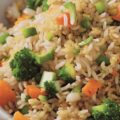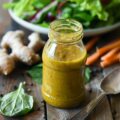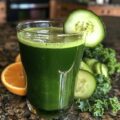A Delicious New Take on a Classic Dish
Kimchi is a staple Korean dish made from fermented vegetables like napa cabbage, radishes, and scallions. This updated recipe puts a fresh spin on the traditional kimchi by incorporating new ingredients like apple, pear, garlic chives, and kombu. The result is a next-level kimchi bursting with complex flavors.
Ingredients
- 1 large or 2 small heads napa cabbage, cut into 2-inch pieces
- 1 Asian pear, peeled and cut into matchsticks
- 1 apple, cut into matchsticks
- 8 ounces Korean radish or daikon, cut into matchsticks
- 4 scallions, cut into 1-inch pieces
- 1⁄2 cup garlic chives, cut into 1-inch pieces
- 1⁄4 cup salt
- 1 piece dried kombu (about 4 by 6 inches)
Step-By-Step Instructions
- Toss the cabbage with the salt in a large bowl. Let stand 1 hour. Rinse under cold water 3 times and drain well.
- In a large bowl, mix together the cabbage, pear, apple, radish, scallions and garlic chives.
- Make the kimchi paste by blending together 1 cup water, 1⁄2 cup rice flour, 1⁄4 cup sugar, 2 tablespoons fish sauce, 10 cloves garlic, a 2-inch piece ginger and 3 tablespoons Korean red pepper powder.
- Add kimchi paste and kombu to vegetable mixture and mix well with clean hands until combined thoroughly.
- Transfer mixture to a 2-quart jar and press down firmly with a spoon to remove any air pockets. Top with a little extra brine if needed to submerge vegetables.
- Let ferment at room temperature for 1-5 days before moving to the refrigerator. Enjoy!
Tips for Best Results
- Use fresh, crisp vegetables for the best flavor and texture.
- The longer you ferment, the sourer the kimchi will taste.
- As it ferments, be sure vegetables stay fully submerged to prevent mold.
- Enjoy kimchi as a side dish, in soups, stews, fried rice, sandwiches and more!
Frequently Asked Questions
What’s the best vegetable to use for kimchi?
Napa cabbage is the most traditional and common vegetable used to make kimchi. It has the perfect crunchy yet tender texture. You can also find radish kimchi, green onion kimchi and kimchi made from other vegetables.
Is it safe to eat very old kimchi?
Most authorities recommend consuming kimchi within 1-2 weeks if kept refrigerated. Very old kimchi may still be safe to eat but it likely won’t taste very good or have the desired sour flavor.
Can I adjust the spiciness?
Absolutely! Add more or less Korean red pepper powder to suit your desired level of heat. For mild kimchi, use just 1-2 tablespoons.
What’s the white stuff on my kimchi?
Don’t worry, that white fuzz is totally normal – it’s just yeast forming during the fermentation process. Simply skim it off the top.
What do I do if my kimchi has mold?
Discard the moldy portions and make sure the remaining veggies stay fully submerged under brine. Mold occurs when air reaches the kimchi. Prevent it by keeping everything submerged.









